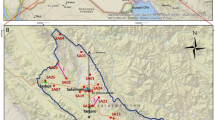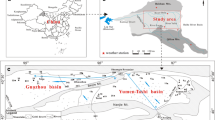Abstract
The hydrogeochemical and isotopic evolution of groundwaters in the Mio–Pliocene sands of the Complexe Terminal (CT) aquifer in central Algeria are described. The CT aquifer is located in the large sedimentary basin of the Great Oriental Erg. Down-gradient groundwater evolution is considered along the main representative aquifer cross section (south–north), from the southern recharge area (Tinrhert Plateau and Great Oriental Erg) over about 700 km. Groundwater mineralisation increases along the flow line, from 1.5 to 8 g l−1, primarily as a result of dissolution of evaporite minerals, as shown by Br/Cl and strontium isotope ratios. Trends in both major and trace elements demonstrate a progressive evolution along the flow path. Redox reactions are important and the persistence of oxidising conditions favours the increase in some trace elements (e.g. Cr) and also NO3 −, which reaches concentrations of 16.8 mg l−1 NO3-N. The range in 14C, 0–8.4 pmc in the deeper groundwaters, corresponds with late Pleistocene recharge, although there then follows a hiatus in the data with no results in the range 10–20 pmc, interpreted as a gap in recharge coincident with hyper-arid but cool conditions across the Sahara; groundwater in the range 24.7–38.9 pmc signifies a distinct period of Holocene recharge. All δ18O compositions are enriched relative to deuterium and are considered to be derived by evaporative enrichment from a parent rainfall around −11‰ δ18O, signifying cooler conditions in the late Pleistocene and possibly heavy monsoon rains during the Holocene.
Résumé
Ce papier décrit l'évolution hydrogéochimique et isotopique des eaux souterraines des sables de l'aquifère du Complexe Terminal, situé dans le vaste bassin sédimentaire du Grand Erg Oriental (nord-est du Sahara algérien). Cette étude a été réalisée selon la principale section transversale nord–sud représentative de l'aquifère, qui représente l'évolution selon un gradient d'écoulement vers l'aval depuis la zone de recharge méridionale (le plateau de Tinrhert et le Grand Erg Oriental), sur environ 700 km. La minéralisation des eaux souterraines augmente le long des lignes d'écoulement et est comprise entre 1.5 et 8 g l−1, avec un accroissement correspondant des concentrations en Na+, Cl−, SO4 2−, Ca2+ et K+. Des traces de minéraux évaporitiques présents dans la matrice de l'aquifère (halite, gypse, sylvite) sont les principaux contrôles minéralogiques. Par ailleurs, les concentrations en HCO3 − et Mg2+ sont relativement constantes du fait de la saturation des eaux en minéraux carbonatés. Des éléments mineurs et en traces (Br−, Sr2+, Li+, B3+, F−, I− et Rb+) suivent les mêmes tendances que les ions majeurs. Les isotopes stables (18O, 2H, 13C) et le radiocarbone sont en accord avec les interprétations hydrochimiques d'une augmentation de l'âge et d'interactions eau–roche. La présence de failles au sud de la ville d'Ouargla provoque une remontée par drainance d'eaux anciennes depuis l'aquifère inférieur du Continental Intercalaire. Les âges déterminés par le radiocarbone permettent d'identifier deux masses d'eau différentes: l'une avec des âges de 1,000–4,000 ans b.p., l'autre avec des âges de 20,000–40,000 ans b.p.
Resumen
Este artículo describe la evolución hidrogeoquímica e isotópica de las aguas subterráneas en las arenas Mio-Pliocenas del acuífero Terminal Complejo, situado en una gran cuenca sedimentaria del Great Oriental Erg (Nordeste del Sáhara argelino). La investigación se ha desarrollado a lo largo de la sección transversal más representativa del acuífero, en dirección Sur-Norte, que representa la evolución del gradiente desde la zona meridional de recarga (plató de Tinrhert y Great Oriental Erg) hasta una distancia superior a 700 km. Se ha determinado que la mineralización de las aguas subterráneas aumenta a lo largo de la línea de corriente, y está comprendida entre 1,500 y 8,000 mg l−1, con un aumento paralelo de iones como el sodio, cloruro, sulfato, calcio y potasio. El control mineralógico se debe principalmente a trazas de minerales evaporíticos en la matriz del acuífero, entre los cuales destaca la halita, los yesos y la silvita. Por otro lado, las concentraciones de bicarbonato y magnesio son relativamente constantes, debido a la saturación de las aguas subterráneas con respecto a los minerales carbonatados. Los elementos menores y traza (bromuro, estroncio, litio, boro, fluoruro, yodo y rubidio) también siguen la tendencia de los iones mayoritarios. Los isótopos estables (18O, 2H, 13C) y el carbono radioactivo son coherentes con las interpretaciones hidroquímicas basadas en el envejecimiento e interacción agua-roca. La presencia de fallas hacia el Sur de la ciudad de Ouargla da lugar a un flujo vertical ascendente de paleoaguas desde el acuífero Continental Intercalaire subyacente. La datación realizada mediante el carbono radioactivo permite identificar dos masas de agua diferentes: una primera en la que el agua tiene una edad comprendida entre 1,000 y 4,000 años, y otra de 20 a 40 años.











Similar content being viewed by others
References
Bel F, Cuche D (1970) Étude des nappes du Complexe Terminal du bas Sahara. Données géologiques et hydrogéologiques pour la reconstruction du modèle mathématique (Investigation of the Complexe Terminal aquifers of lower Sahara: geological and hydrogeological data for the reconstruction of the mathematical model). Tech Rep Direction de l'Hydraulique de la Wilaya de Ouargla, Algeria
Bel F, Demargne F (1966) Étude géologique du Continental Intercalaire (Geological study of the Continental Intercalaire aquifer). Tech Rep ANRH, Algiers
Bel F, Cuche D, Schoute M, Lefort O (1970) Étude du Complexe Terminal. Données hydrogéologiques et géologiques(Study of the Complexe Terminal aquifer: hydrogeological and geological data). Rep ERESS project, Ouargla, Algeria
Conrad G, Fontes JCh (1970) Hydrologie isotopique du Sahara nord-occidental (Isotope hydrology of the north-western Sahara). In: Isotope Hydrology 1970, IAEA, Vienna, pp 405–419
Cornet A (1964) Introduction à l'hydrogéologie Saharienne (Introduction to Saharan hydrogeology). Géogr Phys Géol Dyn 61:5–72
Edmunds WM (1996) Bromine geochemistry of British groundwaters. Mineral Mag 60:275–284
Edmunds WM, Gaye CB (1997) High nitrate baseline concentrations in groundwaters from the Sahel. J Environ Qual 26:1231–1239
Edmunds WM, Smedley PL (2000) Residence time indicators in groundwater: the east Midlands Triassic Sandstone Aquifer. Appl Geochem 15:737–752
Edmunds WM, Miles DL, Cook JM (1984) A comparative study of sequential redox processes in three British aquifers. In: Eriksson E (ed) Hydrochemical balances of freshwater systems. Proc Symp IAHS, September 1984. IAHS Publ no 150:55–70
Edmunds WM, Shand P, Guendouz A, Moulla AS, Mamou A, Zouari K (1997) Recharge characteristics and groundwater quality of the Grand Erg Oriental basin, final report. EC (Avicenne) contract CT93AVI0015, BGS Tech Rep WD/97/46R Hydrogeol Ser
Edmunds WM, Guendouz AH, Mamou A, Moulla AS, Shand P, Zouari K (2003a) Groundwater evolution in the Continental Intercalaire aquifer of southern Algeria and Tunisia: trace element and isotopic indicators. Appl Geochem 18(6):805–822
Edmunds WM, Dodo A, Djoret D, Gasse F, Gaye CB, Goni IB, Travi Y, Zouari K, Zuppi GM (2003b) Groundwater as an archive of climatic and environmental change. The PEP-III traverse. In: Battarbee RW, Gasse F, Stickley CE (eds) Past climate variability through Europe and Africa. Kluwer, Dordrecht, Developments in Palaeoenvironmental Research Series (in press)
Fontes JCH, Yousfi M, Allison GB (1986) Estimation of long-term, diffuse groundwater discharge in the northern Sahara using stable isotope profiles in soil water. J Hydrol 86:315–327
Gasse F (2000) Hydrological changes in the African tropics since the Last Glacial Maximum. Quat Sci Rev 19:189–211
Gonfiantini R, Conrad G, Fontes, JCh, Sauzay G, Payne BR (1974) Étude isotopique de la nappe du Continental Intercalaire et de ses relations avec les autres nappes du Sahara septentrional (Isotopic investigation of the Continental Intercalaire aquifer and its relationship with other aquifers in the northern Sahara). In: Isotope Techniques in Groundwater Hydrology, Vienna. IAEA SM-182/25, vol 1, pp 227–241
Guendouz A (1985) Contribution à l'étude hydrochimique et isotopique des nappes profondes du Sahara septentrional, Algérie (A contribution to the hydrochemical and isotopic study of the northern Sahara deep groundwaters in Algeria). Thesis, University Paris-sud, Orsay, France
Guendouz A, Moulla AS (1995) Étude hydrochimique et isotopique des eaux souterraines de la cuvette de Ouargla, Algérie, 1993–1995 (Hydrochemical and isotopic investigation of Ouargla depression groundwaters, Algeria, 1993–1995). Tech Rep CDTN/DDHI, Algiers, 107 pp
Guendouz A, Moulla AS, Edmunds WM, Shand P, Zouari K, Mamou A (1997) Palaeoclimatic information contained in groundwaters of the Grand Erg Oriental, North Africa. In: Int Symp Isotope Techniques in the Study of Past and Current Environmental Changes in the Hydrosphere and Atmosphere, Vienna, 14–18 April 1997. IAEA-SM-349-/43
Hem J (1985) Study and interpretation of chemical characteristics of natural water, 3rd edn. US Geol Surv Water Supply Pap 2254, 263 pp
Herczeg AL, Edmunds WM (1999) Inorganic ions as tracers. In: Cook PG, Herczeg AL (eds) Environmental tracers in subsurface hydrology.. Kluwer, Boston, pp 31–77
Maley J (2000) Last Glacial maximum lacustrine and fluviatile formations in the Tibesti and other Saharan mountains, and large scale teleconnections linked to the activity of the Subtropical Jet Stream. Global Planet Change 26:105–120
Paix P (1956) Les nappes artésiennes de l'Oued Rhir (Artesian aquifers of the Wadi Rhir valley). Thesis, Science Faculty, Algiers University, 125 pp
Petit-Maire N, Riser J (1982) Sahara ou Sahel: Quaternaire Récent du Bassin de Taoudenni, Mali (Sahara or sahel, recent Quaternary of the Taoudenni region in Mali). CNRS, Lamy, Marseille, 473 pp
Sonatrach (1992) Geology of the Great Oriental Erg. Société Nationale des Hydrocarbures, Hassi-Messaoud, Tech Rep, 20 pp
Sonntag C, Klitsch E, Lohnert EP, El-Shazly EM, Munnich KO, Junghans Ch, Thorweihe U, Weistroffer K, Swailem FM, (1979) Palaeoclimatic information from deuterium and oxygen-18 in carbon-14 dated north Saharan groundwaters. In: Isotope Hydrology 1978, Vienna. IAEA, pp 569–581
UNESCO (1972) Projet ERESS: étude des ressources en eau du Sahara septentrional. Rapport final (ERESS project: study of the northern Sahara water resources. Final report). United Nations Educational Scientific and Cultural Organisation (UNESCO), Paris
Acknowledgements
The work was carried out within the framework of a project partly supported by the European Commission under the programme Avicenne (contract no. CT 93AVI0015). We thank Sonatrach for hosting us while in the field for sampling. We thank Fiona Darbyshire (NIGL Keyworth) for conducting strontium isotope analyses, and the staff of the Centre de Recherche Nucléaire d'Alger (CRNA) for other isotope analyses. Additional radiocarbon analysis was conducted through the NERC Radiocarbon Laboratory, East Kilbride, under research allocation 779/0119. This paper is published with the permission of the directors of the CRNA and the British Geological Survey (Natural Environment Research Council).
Author information
Authors and Affiliations
Corresponding author
Rights and permissions
About this article
Cite this article
Guendouz, A., Moulla, A.S., Edmunds, W.M. et al. Hydrogeochemical and isotopic evolution of water in the Complexe Terminal aquifer in the Algerian Sahara. Hydrogeology Journal 11, 483–495 (2003). https://doi.org/10.1007/s10040-003-0263-7
Received:
Accepted:
Published:
Issue Date:
DOI: https://doi.org/10.1007/s10040-003-0263-7




